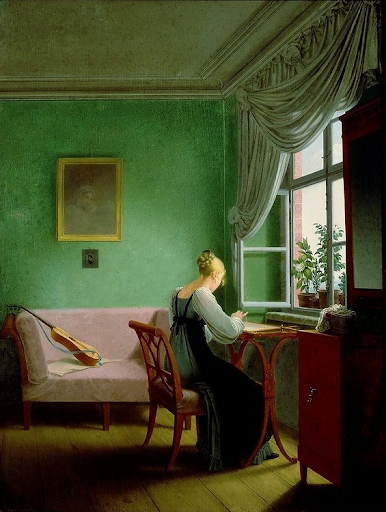Feeling Green? Death on the walls, a history of scheele’s green
EMBROIDERY WOMAN, GEORG FRIEDRICH KERSTING, 1817.
The colonial era was a period of new architectural and decorative trends, trends that remain iconic today. Rustic wooden features and delicate patterns assisted in adding glamor to a life that was otherwise focused on functionality over fashion. Bright, beautiful wallpapers and paints added a pop of color, adding to the lively interiors of elite homes in the upper crust of pre-victorian society.
In fact, these bright colors were so popular that many scientists from all over the world dedicated their research to the science of color theory, hoping to make their wealth pandering to the artistic eye of the elites. One of these scientists, Swedish chemist Carl Wilhelm Scheele developed a gorgeous green pigment in 1771 that gained worldwide notoriety. Walls painted with this “Scheele’s Green”, as it is known today, became the envy of high society. He made this pigment using a compound of copper arsenite, perfecting his timeless pigment with verdigris and arsenic.
That’s right- he used arsenic in a pigment meant to surround families in their close-quartered homes. He even knew of arsenic’s poisonous persona when he made the paint, however; at the time it was widely believed that a small quantity of arsenic was acceptable in luxury items such as face powder, pottery, clothing, and of course, interior decor.
Arsenic continued to be used in wallpapers and interior paints for over 100 years, continuing its hidden tirade on families well into the Victorian Era. Of course, during this time, many people were getting sick and dying, children were known to “waste away in their sleep” according to medical journals of that period. Unfortunately, the public failed to make the connection between the two until around 1889, when the first regulations on the use of arsenic were introduced.
Arsenic affects each person differently. In drier climates, arsenic poisoning was less common due to the lack of humidity dispersing the fumes. Some consumers of arsenic also had higher tolerances to the poison than others- a young, healthy person living in a home painted with arsenic may only have slight headaches, easily attributed to other factors. An older person or a young child living in the same home could easily fall ill or even die, despite having the same exposure to the paint.
Over time, people began noticing the pattern of young children and elderly residents dying when living in a house painted with an arsenic compound. With regulations finally placed on the commercial use of arsenic, the death toll in regulated communities decreased significantly. However, arsenic was still used for rat poison and other insecticides until 1986, when arsenic was finally deemed unsafe and banned completely.
Despite arsenic being rightfully discontinued, people still love the vibrant hue of Scheele’s Green. Many manufacturers still make this particular color, however they’ve altered the compound to disinclude the harmful poison.
Source:
https://laafa.edu/poisonous-pigments-scheeles-green/
https://www.theparisreview.org/blog/2018/05/02/scheeles-green-the-color-of-fake-foliage-and-death/
